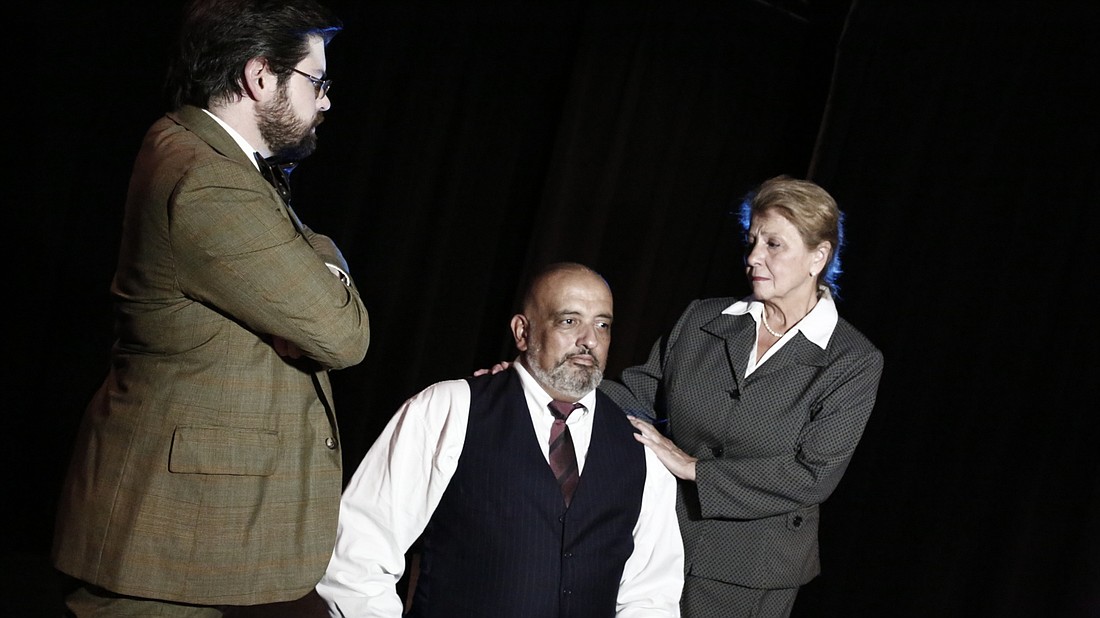- November 23, 2024
-
-
Loading

Loading

Michael Frayn’s “Copenhagen” is taking audiences on a long, strange trip at the Manatee Players in a Little Grey Hat production. It’s a fantasy fueled by physics and three high-stakes questions: What would Hitler have done with the atomic bomb? Why didn’t he get one? (We’ll get back to the third question later.)
By way of background, Einstein’s theory of relativity threw a monkey wrench into the clockwork machinery of the Newtonian universe at the dawn of the 20th century. Werner Heisenberg (Dylan Jones) did him one better. His uncertainty principle plunged the universe down the rabbit hole into a Wonderland of indeterminacy. Heisenberg’s iffy universe rubbed Einstein the wrong way. “God does not play dice” was his famous response.
These abstract issues became intensely personal at the outbreak of World War II. At Einstein’s urging, the United States was hard at work developing a fission bomb. The Nazis lagged behind, as all of Germany’s Jewish physicists had fled persecution. But Heisenberg, German to the bone, remained. The Nazis put him to work on their ultimate wonder weapon. Heisenberg didn’t get very far thanks to a simple math error. And he was one of the greatest math geniuses of all time.
That’s the set-up for the play. It revolves around a famous (and famously uncertain) conversation.
In September, 1941, Heisenberg paid a visit to his friend, mentor and colleague, Niels Bohr (David Yamin), a half-Jewish physicist living in Copenhagen in Nazi-occupied Denmark. To avoid Gestapo surveillance, the two took a walk on a secluded lane. Then Heisenberg spilled a state secret. He was working on the “Uranium problem,” which might have “grave consequences in the technique of war.” The talk went downhill from there and they soon parted company. But what exactly did they say?
After the war, the two men recalled the conversation in very different ways. In Bohr’s account, Heisenberg was trying to get Bohr’s talents on the winning side. After all, the German invasion of Russia was in full force, and it looked like the “unstoppable Nazi war machine” was winning. Heisenberg also seemed to be pumping Bohr for inside information about the Allied nuclear program. In Heisenberg’s recollection, he was hinting that nuclear fission could be achieved, but letting Bohr know that he was dragging his heels — and hoping that Bohr could convince Allied physicists to follow his example and keep the nuclear genie in the bottle.
Instead of a literal historical drama, Frayn shifts the discussion to the afterlife. Somewhere in the next world, Heisenberg, Bohr and Bohr’s wife, Margrethe (Caroline Cox) continually rehash the fateful talk. The play’s structure mimics the uncertainty principle itself. Instead of the typical “I said this; you said that,” the dialog is more like, “What did I say? What did you say? What were you thinking?” Instead of one truth, we get several truths, Rashomon-style. The account emerges and eventually clarifies from a cloud of uncertainty.
Frayn’s dialog creates an antiphonal music as the characters take turns piecing the fragments of lost time together. Director Heiko Knipfelberg conducts that verbal music beautifully. To switch metaphors, Frayn’s play is a movie of the mind. Words paint pictures of the physicists’ conversation, the shadows of Castle Elsinore, an SS officer pulling a Luger on Heisenberg, Bohr fleeing a round-up of the Jews in a fishing boat, and other scenes Stay with it, and the picture is crystal clear. Knipfelberg’s specific, character-centered direction keeps it that way.
And let’s be clear about Frayn’s characters. The uncertainty principle is no New Age excuse for lazy writing here. Bohr, Heisenberg and Margrethe are very well drawn and speak in distinctive voices. It takes genius to make your geniuses sound like people.
The same applies to heroes, but the actors are up to the heroic task. Jones’ Heisenberg and Yamin’s Bohr form a perfect physical and psychological complement. (The Warner Brothers’ Chester and Spike cartoons come to mind.) The younger Heisenberg is either spaniel-like and eager or moody and depressed. The larger Bohr is the bulldog in this relationship — solid, unflappable, tough. Cox’s Mergrethe is the still, emotional center between the two. The sane one, with her feet planted firmly in common sense reality.
One reality matters most of all: choice.
The play implies that you can’t know yourself directly, but only by the decisions you make. Which brings us to the third question: Was Heisenberg’s math error a way of dragging his feet? Specifically, he’d estimated that you’d need a lump of U-235 the size of a Buick to start a chain reaction when a tennis ball-sized lump would do. But Heisenberg never actually did the math. Was the mistake a delaying tactic, or just a mistake? Frayn has definite opinions on this score. Sorry to leave you in a state of uncertainty, but you’ll have to see the play to find out.
And to be fair, the play’s three big questions are accompanied by lots of small, interesting questions about everything from the secrets of the human heart to the nuances of physics and math.
It all adds up to seamless blend of moral philosophy, the detective work of physics, and plenty of mordant comic moments as well. “Copenhagen” is not fluffy, escapist fare. If you’re looking to turn your mind off, this is not the play for you. If you can keep your mind in the game, your reward will be great.
I’m certain about that.